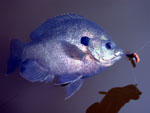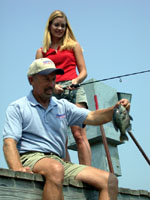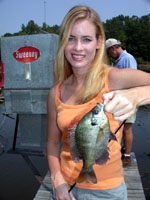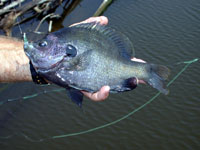
|
Features
|
|
|
|
Books
|
|
|
|
Fun & Games
|
|
|
|
Contact Us
|
|
|
John's Journal... Entry 164, Day 2
GIANT BLUEGILLS
How to Prepare Your Pond to Grow Super Bluegills
 EDITOR'S
NOTE: Barry Smith of Montgomery, Alabama, a longtime fisheries biologist,
co-owns American Sport Fish in Pike Road, Alabama, one of the largest
private hatcheries in the Southeast, with his partner Don Keller. Smith
and Keller have developed several breeds of fish that landowners enjoy
stocking in their ponds. This week we'll talk with Smith about the giant
bluegills American Sport Fish stocks.
EDITOR'S
NOTE: Barry Smith of Montgomery, Alabama, a longtime fisheries biologist,
co-owns American Sport Fish in Pike Road, Alabama, one of the largest
private hatcheries in the Southeast, with his partner Don Keller. Smith
and Keller have developed several breeds of fish that landowners enjoy
stocking in their ponds. This week we'll talk with Smith about the giant
bluegills American Sport Fish stocks.
Question: Barry, what do you recommend that someone use
to prepare a pond to grow super bluegills?
Answer: One of the most-important things in preparing your pond to grow
big bluegills is to make sure you don't have any other competing fish
in your pond when you stock it. However, there will be plenty of wild
fish in there, and that's very important. Unless your pond is in the Black
Belt area of Alabama, more than likely you'll have to lime that pond before
the pond is ever filled.
 With most of the soil types in Alabama and throughout the Southeast, each
acre of pond will need a minimum of four tons of lime to make a significant
difference in your water quality. This lime should be applied while the
bottom is dry -- if possible. Then once you fill the pond, you need to
start a good fertilization program to increase the food supply for these
bluegills and enable them to grow at a much faster rate. Of course, the
most-important thing then is to supplementally feed your bluegills with
an automatic feeder.
With most of the soil types in Alabama and throughout the Southeast, each
acre of pond will need a minimum of four tons of lime to make a significant
difference in your water quality. This lime should be applied while the
bottom is dry -- if possible. Then once you fill the pond, you need to
start a good fertilization program to increase the food supply for these
bluegills and enable them to grow at a much faster rate. Of course, the
most-important thing then is to supplementally feed your bluegills with
an automatic feeder.
Question: How many feeders do you recommend pond owners
put out per acre, and how much food does each feeder need to put out?
Answer: We usually recommend one feeder for about every three to five
surface acres. That does a very good job in most ponds. During the spring
and the fall, we like to feed four times during the day: early morning,
late afternoon and two times during the middle of the day. Be sure to
monitor your feeding, so that the fish are able to clean up their feed
in about five minutes.
 Question:
You determine how much feed to put out by how much the bluegills can eat
in five minutes, right?
Question:
You determine how much feed to put out by how much the bluegills can eat
in five minutes, right?
Answer: That's correct. If they eat all that feed up in 60 seconds, then
you're not putting out enough feed. So time the amount of feed that goes
out, which typically may be only small amounts as you start out. But as
the fish grow and become more aggressive on that feeder, you may be feeding
5 pounds per feeding, depending on how many fish you have coming in there.
Question: Typically, what does it cost to feed a 5-acre
pond to raise giant bluegills for a year?
Answer: John, usually a 50-pound of feed costs about $10 a bag. We recommend
not feeding over 10 pounds per acre per day. You can figure out the cost
of that depending on how many feeders you have and how much feed you put
out per acre. Most of the time, when you're feeding from an automatic
feeder, if your pond is 5 acres in size, you usually won't use 10 pounds
of food per acre. So typically, you will be feeding around 5 pounds per
acre a day around each feeder. So a 50-pound bag will last anywhere from
a week to 10 days per feeder.
 Question:
Also, at what rate and what kind of fertilizer do you recommend for a
pond?
Question:
Also, at what rate and what kind of fertilizer do you recommend for a
pond?
Answer: There are a number of fertilizers on the market that work extremely
well. The two most-popular fertilizers that we have available now for
ponds are a liquid fertilizer, which is a 10340, clear green liquid that
has to be applied by mixing this fertilizer with water. One of most-recent
fertilizers that's on the market is a totally dissolvable powder that
doesn't have to be mixed. You can throw this easy-to-use fertilizer directly
in the pond. Typically we use 5 to 8 pounds per acre per application.
Question: How often should we fertilize our farm ponds?
Answer: Well, that time depends on the individual pond. Some books that
you read will tell you to fertilize every 30 days. But typically you need
to fertilize by color. Start out in the spring, usually by the end of
February or the beginning of March, and fertilize it until you get a green
color. Try to maintain that visibility and green color to a depth of 16
or 20 inches. Continue fertilizing. As it thins out or clears up, add
more fertilizer. In the summertime when the weather gets really hot, let
the visibility get between 20 and 24 inches. Slow up on your fertilizer,
so you don't have to fight a real heavy bloom and run the risk of having
a fish kill.
Question: What size coppernose should we stock and why,
and what stocking rate should we use?
Answer: In a fertilized pond, we usually stock about 1000, 2-inch-long
coppernose bluegills per acre. The coppernose is a good healthy fish and
can make it through the harsh winter, without stressing. If you stock
these fish in the early fall, you'll get extremely good growth out of
them December. These fish will become sexually mature early in the spring,
typically around the first of May, and will be ready to spawn as soon
as the water temperature warms up.
Question: What does the coppernose bluegill cost?
Answer: Coppernose fingerlings usually run about 20 cents each. So, if
you're stocking 1000 coppernose per acre, then you'll be looking at about
$200 an acre to stock these fingerlings.
Question: And the coppernose bluegills aren't sterile
and will reproduce, right?
Answer: That's correct. These bluegills aren't hybrids. They will reproduce
as much as a common bluegill does. One of the reasons that we stock bass
in combination with these is so that we can control that reproduction
rate of the bluegills, and your bass and your coppernose will grow. To
learn more about American Sport Fish, write P.O. Box 20050, Montgomery,
AL 36120, or call (334) 281-7703.
TOMORROW: HOW TO HAVE A POND WITH THE MOST-CATCHABLE BIG BLUEGILLS
Check back each day this week for more GIANT BLUEGILLS ...
Day 1 - Giant Bluegills
Day 2 - How to Prepare Your Pond to Grow
Super Bluegills
Day 3 - How to Have a Pond with the Most-Catchable
Big Bluegills
Day 4 - Help Your Farm Pond Produce Better
Day 5 - Facts About Coppernose Bluegills